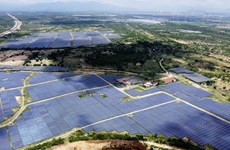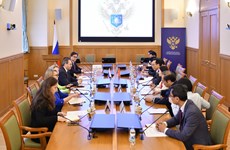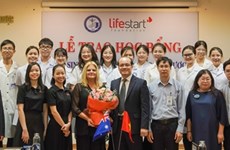Workshop explores worship of Mother Goddesses
The worship of Mother Goddesses plays an important role in the spiritual life of Vietnamese
people and others in some areas in Southeast Asia, according to
participants at a recent workshop in the northern province of Nam
Dinh.
The worship of Mother Goddesses plays an important role in the spiritual life of Vietnamese
people and others in some areas in Southeast Asia, according to
participants at a recent workshop in the northern province of Nam
Dinh.
The two-day workshop, which ended on Sept. 30, also drew representatives from communities practising the worship besides scholars, researchers and cultural workers.
All the speakers shared the same opinion that the worship is a popular belief in all ethnic communities in Vietnam and others in wet-rice cultivation areas in the region.
The belief pays particular respect to the creative and productive power of the Divine Mother in nature, similar to the Earth Mother in Stone-Age Western religion. It uses the figure of the Mother in a myriad forms to pray for luck and protection and reflects a main feature of Vietnamese life – appreciation of the value and the role of women in the family and community life.
Professor Ngo Duc Thinh, director of Vietnam Belief Culture Research and Preservation Centre in Hanoi , noted that the religion had become a national development in Vietnam in recent centuries.
The belief considers the natural world and humans as a unified and identical entity, he said, in which the Mother of human beings is also "Mother of Nature".
Mother worship can appear in many forms. There are Rain Mother, Cloud Mother, Thunder Mother, Lightning Mother, and mothers of the five basic elements – Metal, Wood, Water, Fire and Earth.
Thinh said there were also nature controllers such as the Heavenly Mother controlling the skies, the Earth Mother controlling all the land, the Water Mother controlling rivers, streams and the seas – and the Mountain Mother who looks after the mountains and forests.
The symbolic Mother can protect people and bring good fortune. This is expressed at many festivals and in legends and customs.
The Mother also includes earthly figures such as Mother Au Co, the legendary Mountain Fairy whose children were the progenitors of the Vietnamese people. Her husband was the Dragon King Lac Long Quan.
This helps explain why the worship is so nationalistic. Not only does it honour Au Co, but it also takes in the historic Trung sisters who fought the Chinese invaders in AD 43 and defeated them.
It also includes national heroine Lady Trieu who defeated the northern invaders in 248. It is this association with the primeval Mother Goddess and historic or legendary female heroines and outstanding characters that has helped give the Vietnamese their strong brand of nationalism and individual brand of spirituality.
It is a spirituality that exists in its own temples beside the introduced religions of Buddhism, Confucianism and Taoism.
Thinh said that unlike other beliefs, the worship of Mother Goddesses does not dwell on guiding people in the world after death, but tends to focus on the real world in which people are living in – and their needs for health, wealth and prosperity.
"It is an active way of thinking, similar to realistic ideology of Vietnamese people," he said.
At the workshop, many speakers raised concerns about the local arts of “chau van”, a kind of spiritual ritual combining folk singing, dancing – and “hau dong” involving women mediums going into trances, which are usually performed in rituals to worship Mother Goddesses.
According to statistics from the culture ministry, Nam Dinh possesses 287 temples and vestiges relating to the Mother Goddess belief. It is estimated that there are about 600 artists practising the rituals in the province, including 246 mediums, 245 cung van (chau van singers) and 162 musical instrumentalists.
The art form was created during the Tran dynasty (1225-1400) and has become popular at festivals and rituals. It is performed at temples and pagodas as people believe it is the best way to connect to the Mother Goddesses.-VNA
The two-day workshop, which ended on Sept. 30, also drew representatives from communities practising the worship besides scholars, researchers and cultural workers.
All the speakers shared the same opinion that the worship is a popular belief in all ethnic communities in Vietnam and others in wet-rice cultivation areas in the region.
The belief pays particular respect to the creative and productive power of the Divine Mother in nature, similar to the Earth Mother in Stone-Age Western religion. It uses the figure of the Mother in a myriad forms to pray for luck and protection and reflects a main feature of Vietnamese life – appreciation of the value and the role of women in the family and community life.
Professor Ngo Duc Thinh, director of Vietnam Belief Culture Research and Preservation Centre in Hanoi , noted that the religion had become a national development in Vietnam in recent centuries.
The belief considers the natural world and humans as a unified and identical entity, he said, in which the Mother of human beings is also "Mother of Nature".
Mother worship can appear in many forms. There are Rain Mother, Cloud Mother, Thunder Mother, Lightning Mother, and mothers of the five basic elements – Metal, Wood, Water, Fire and Earth.
Thinh said there were also nature controllers such as the Heavenly Mother controlling the skies, the Earth Mother controlling all the land, the Water Mother controlling rivers, streams and the seas – and the Mountain Mother who looks after the mountains and forests.
The symbolic Mother can protect people and bring good fortune. This is expressed at many festivals and in legends and customs.
The Mother also includes earthly figures such as Mother Au Co, the legendary Mountain Fairy whose children were the progenitors of the Vietnamese people. Her husband was the Dragon King Lac Long Quan.
This helps explain why the worship is so nationalistic. Not only does it honour Au Co, but it also takes in the historic Trung sisters who fought the Chinese invaders in AD 43 and defeated them.
It also includes national heroine Lady Trieu who defeated the northern invaders in 248. It is this association with the primeval Mother Goddess and historic or legendary female heroines and outstanding characters that has helped give the Vietnamese their strong brand of nationalism and individual brand of spirituality.
It is a spirituality that exists in its own temples beside the introduced religions of Buddhism, Confucianism and Taoism.
Thinh said that unlike other beliefs, the worship of Mother Goddesses does not dwell on guiding people in the world after death, but tends to focus on the real world in which people are living in – and their needs for health, wealth and prosperity.
"It is an active way of thinking, similar to realistic ideology of Vietnamese people," he said.
At the workshop, many speakers raised concerns about the local arts of “chau van”, a kind of spiritual ritual combining folk singing, dancing – and “hau dong” involving women mediums going into trances, which are usually performed in rituals to worship Mother Goddesses.
According to statistics from the culture ministry, Nam Dinh possesses 287 temples and vestiges relating to the Mother Goddess belief. It is estimated that there are about 600 artists practising the rituals in the province, including 246 mediums, 245 cung van (chau van singers) and 162 musical instrumentalists.
The art form was created during the Tran dynasty (1225-1400) and has become popular at festivals and rituals. It is performed at temples and pagodas as people believe it is the best way to connect to the Mother Goddesses.-VNA













